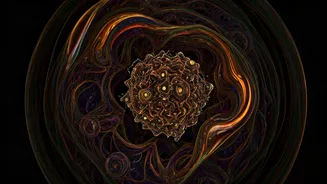Order and Disorder
Typically, matter exists in phases defined by consistent order or disorder. For instance, a crystal showcases a high degree of order, while a gas displays
significant disorder. The newly discovered phase, however, presents a dynamic situation. Within this phase, order and disorder are not static but fluctuate in time. The material's structure does not settle into a single, permanent state. Instead, it oscillates, creating a dynamic interplay between order and chaos. This continuous shift challenges traditional classifications of matter and opens new perspectives on material properties. The interplay of order and disorder is a fundamental aspect of material science, influencing physical properties like conductivity and magnetism. This discovery moves beyond fixed states to consider a temporal dimension in material behavior.
Temporal Fluctuations Explained
The key characteristic of this phase is its temporal behavior. Unlike static phases where properties remain relatively constant, this new phase exhibits ongoing fluctuations. Order and disorder do not exist simultaneously in a fixed arrangement, but rather alternate over time. Picture it like a dance between two states. The material's structure transitions between ordered and disordered configurations, leading to a constant transformation. These fluctuations are not random; they exhibit specific patterns. This means there's an underlying mechanism driving these shifts. Understanding this mechanism is key to harnessing the properties of this unique material phase. This temporal aspect is significant because it suggests potential applications in areas like data storage and novel computing.
Unusual Material Properties
This dynamic interplay of order and disorder has significant implications for the material’s properties. Since the structure is constantly evolving, the material’s characteristics, like its response to external stimuli, also change. For example, its conductivity or its magnetic behavior might show unusual patterns. The constantly changing structure means that the material does not exhibit steady-state behavior. Instead, it responds dynamically to different inputs. This dynamism allows the material to perform functions that are impossible for materials with fixed structures. It could lead to novel applications in areas requiring dynamic responses, such as sensors or adaptive materials. Researchers may find that the material responds differently under changing conditions, revealing unexpected responses.
Implications and Future Research
The discovery of this novel phase of matter has far-reaching implications, extending from fundamental physics to potential technological applications. The finding challenges existing models of material behavior and prompts a re-evaluation of how we categorize different states of matter. Moreover, it creates new research avenues to explore the mechanisms behind this unique temporal behavior. Scientists will investigate the factors that control the oscillations between order and disorder. This includes exploring the impact of temperature, pressure, and other external influences on the material's behavior. Understanding the dynamics could lead to designing new materials with tailored properties. This could open doors to innovative technologies in areas like energy storage, computation, and sensing, offering previously unimaginable functionalities.




